Style: Men’s & women’s
Sample Size: EU44 / UK10 / US10.5
Other names: Surf shoe, bathing shoe, aqua shoe
Design: Nika Holding GmbH (Germany)
Country of production: Unknown
Weight per shoe*: 130 gr. (4.59 oz.) (blue model) – 224 gr. (7.90 oz.) (green model)
Thickness of sole*: 4.5 mm. (0.1772 in.)
Outer material Textile: Nylon, Mesh
Inner material: Nylon
Insole: EVA
Outsole: TPR (Thermo Plastic Rubber)
Price: €5 (around $6.80)
*Weight and thickness are always measured without insole when possible (since I usually recommend losing the insole, thus making the shoe more minimal). The weight is found using electronic scales from OBH that weigh down to 1 gram. The thickness is measured with a one-handed bar clamp. The thickness and especially weight are of course dependent on shoe size (See above).
The product
The water shoes reviewed here are made by the German company Nika Holding GmbH (maybe not the black ones, which I couldn’t find any info on). You can buy water shoes from all other kinds of producers, and they will probably do just as well (though the material may vary a lot – some water shoes are in plastic or rubber, others are made of more expensive materials that improve breathability). These specimens have a Thermo Plastic Rubber outsole (TPR), so if the review makes you want to buy some water shoes, you may want to notice this detail.
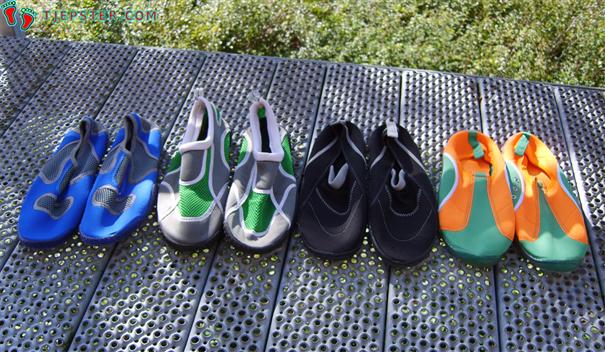
Water shoes can be bought in malls or supermarkets and they are usually quite easy to acquire (otherwise: search the internet for “water shoes”, “water socks”, “surf shoes”, “bathing shoes”, or something similar). The shoes reviewed here were bought in the supermarkets Aldi and Ftex, and the price was fantastic: €5 (about $6.8)! At that price I could buy many specimens and still save money compared to buying a normal, cheap shoe. They are designed by the Textil-Schuh-Vertrieb department of Nika Holding, as far as I can figure (the wrapping says NIKA TSV), but exactly where they are made I can’t say for sure. If they are made in the EU the price is incomprehensible.
The fabric is soft and feels nice and the sole is very elastic. The shape of the shoe is too pointy, though – not much room for your toes. Overall the shoe looks very cheap (which it is – it even comes in a plastic bag), and you can’t keep from wondering how long they will last before falling apart (we will return to this in a moment).
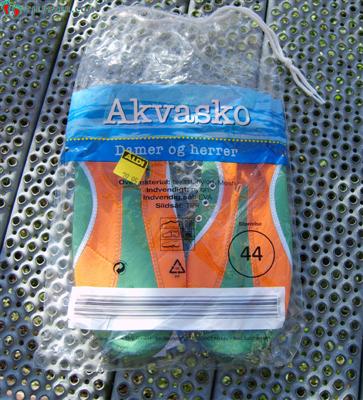
Use
I have used the water shoes both for trekking, running, and normal walking around. The green ones have somewhat the look of a normal shoe because of their black outsole and sneaker looking design, so they have become my favourite walking shoes. People don’t turn their eyes.
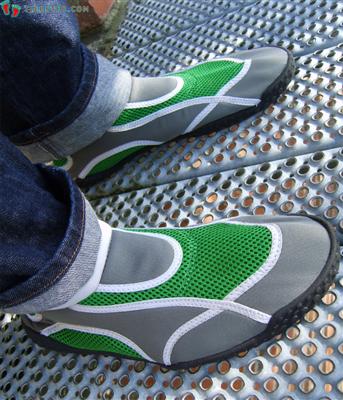
The blue ones have become my favourite running shoes. They fit very well and have a lot of net fabric – which means that they are a bit more breathable than the orange and black ones.
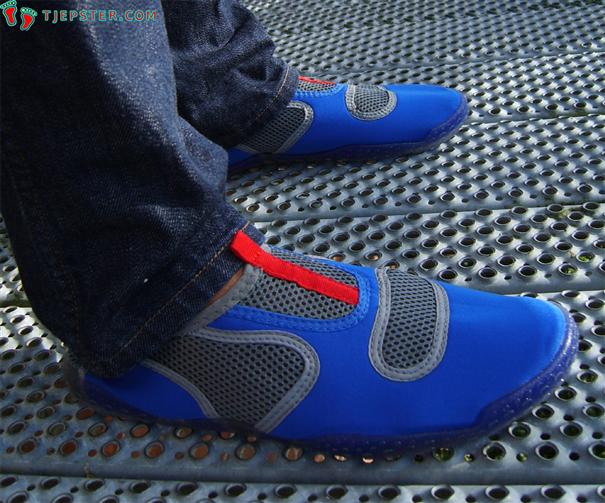
The fabric tends to keep water or moisture inside the shoe, which means very warm feet – good when you bathe, but it causes very poor breathability. Some of them have net material that gives better ventilation, but overall your feet get hot inside the nylon fabric and the shoes get smelly quickly. They can be thrown into the washing machine, though. The fabric also works the other way around – repelling a small amount of water, so they will keep your feet somewhat warm during wintertime (they are not water resistant, though!).
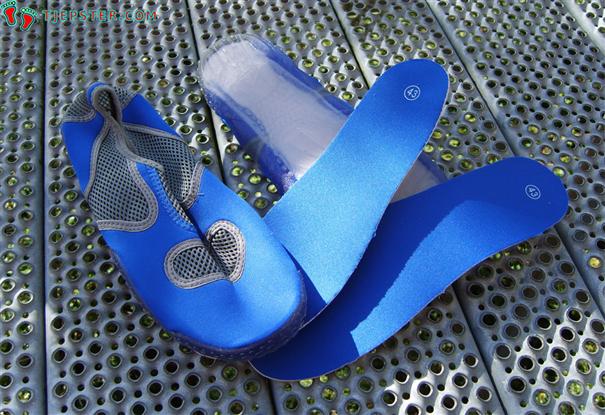
Regarding flexibility they are as elastic as can be (they can be rolled up like a piece of paper – see image below). A thin Thermo Plastic Rubber sole makes your feet feel free and offers great contact with the surface. It is very skid resistant as well (they are supposed to keep you from falling when standing on wet surfaces) – but be aware of wet grass or slippery stones. It is a very good idea to lose the insole – A) because it wears out pretty quickly, B) because it keeps popping out of the shoe when running, C) because you get an even greater flexibility and surface contact without it.
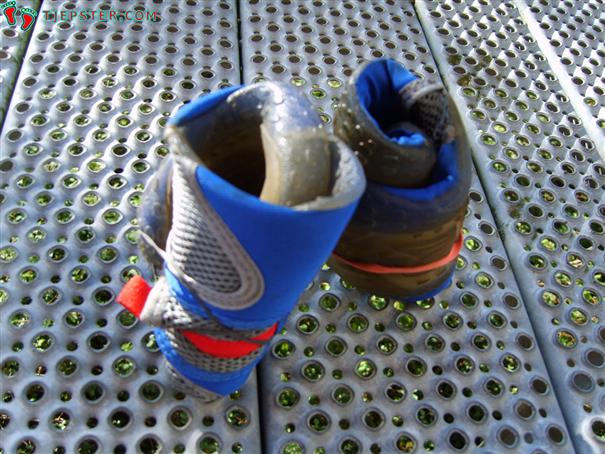
I was amazed how durable the shoes happened to be, thinking on their cheap look. The green ones fell apart pretty quickly (maybe a clear TPR sole is simply better than a black one), but the blue ones ended up lasting close to 1000 km. (621 miles), before openings appeared in the sole. 1000 km., with machine washing and all, is insane for a shoe that cheap. And the best part: The shoes only get better as they wear out – the sole becomes thinner and more lightweight along the way. An almost worn-out water shoe is simply a brilliant minimal shoe.
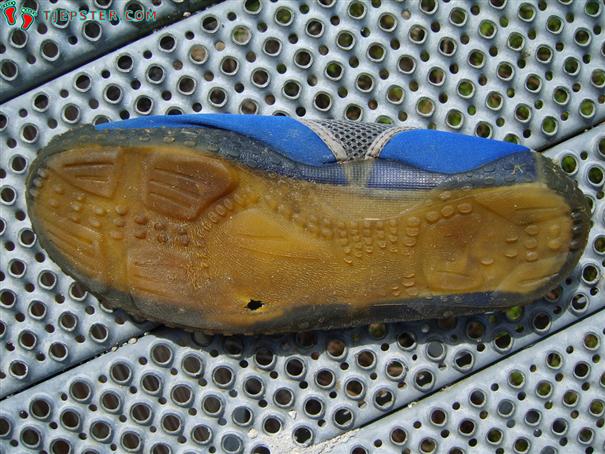
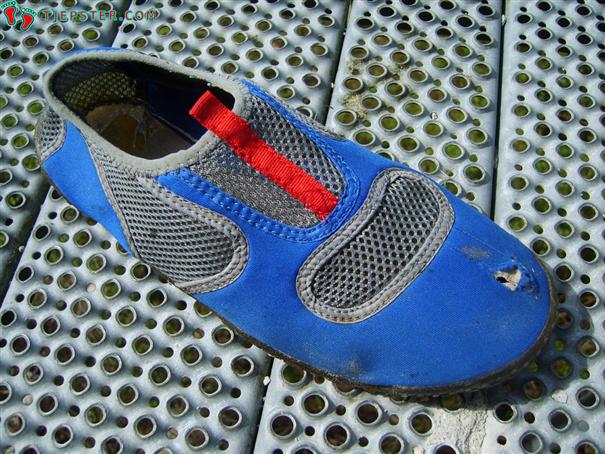
One nice thing about your foot is its toes. They help you with that last bit of control over your feet. More room for the toes is a good thing – A) because it feels great, B) because squeezing them together makes them sweat more and gives your foot an ill form. In water shoes (at least these ones) your toes are neglected, unfortunately.
It should of course be mentioned that the water shoes are ultra light weight (especially without the insole). Taking off your normal shoes and slipping into these feels like being set free. Except for the toes that are being squeezed you don’t notice them. Also they are very easy to put on – no laces, just elastics (again, this may vary).
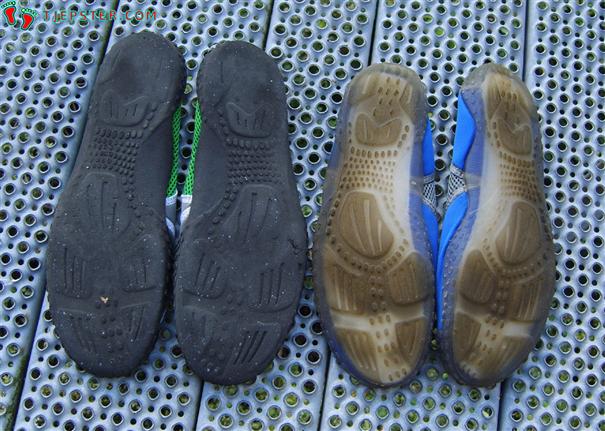
If we consider walking in water shoes, let’s start by noting how pleasant they are to have on, which is mainly because of the soft fabric (no leather, no laces, and no stiff parts). However, using them for a whole day of walking is unwise, since your feet get burning hot and sweaty – even when you don’t use socks. But for short trips they work.
Running in water shoes is a really great experience. You will appreciate that they don’t weigh much more than your socks (which you can keep off, unless it gets really cold). If it was not for their poor breathability and the fact that your toes are pulled a bit together I would say that we almost have the perfect running shoe. They offer minimal protection, which is what we are looking for – meaning that they become a small piece of extra skin under your feet. Your skin still gets to toughen, which is especially important when running or walking barefooted. Leather skin is a must (though your zone therapist might not think the same).
Conclusion
[Rated: 8/10 Toes]
Water shoes with a TPR sole are optimal for front- or midfoot landing. They are a very good supplement to running barefooted. You rarely even notice that you are wearing them. But it is a downside that they are poorly ventilated, and I really wish I could find some specimens that were much wider in the front to keep my toes from being pulled together. But this is a problem with almost all shoes.
I would recommend water shoes for any use, though – as long as you don’t wear them for too long at a time. Overall, you simply can not complain about water shoes, their price considered. They are lightweight, they are flexible, and they get better the more you use them. They are a perfect example of a minimal shoe – even though they were not made for this particular purpose.
Finally, the TPR is a fantastic material. It is soft enough to let you feel every little dent in the surface, but it is incredibly hard to wear out. It acts like a perfect extension of the foot, and it is absolutely one of the best sole materials for minimal shoes, in my opinion.
Water shoes are a perfectly safe and minimal investment. Not much to lose, but plenty to gain.